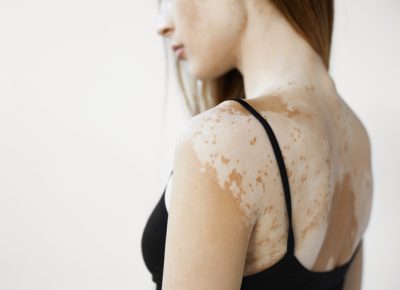Vitiligo
 Vitiligo is a skin condition resulting from loss of pigment which produces white patches. Any part of the body may be affected. Usually both sides of the body are affected. Common areas of involvement are the face, lips, hands, arms, legs, and genital areas. Vitiligo affects one or two of every 100 people. About half the people who develop it do so before the age of 20; about one–fifth have a family member with this condition. It may be an autoimmune process as the body makes antibodies to its own pigment cells. Most people with vitiligo are in good general health, although vitiligo may occur with other autoimmune diseases such as thyroid disease.
Vitiligo is a skin condition resulting from loss of pigment which produces white patches. Any part of the body may be affected. Usually both sides of the body are affected. Common areas of involvement are the face, lips, hands, arms, legs, and genital areas. Vitiligo affects one or two of every 100 people. About half the people who develop it do so before the age of 20; about one–fifth have a family member with this condition. It may be an autoimmune process as the body makes antibodies to its own pigment cells. Most people with vitiligo are in good general health, although vitiligo may occur with other autoimmune diseases such as thyroid disease.
According to The American Academy of Dermatology, treatments for vitiligo include:
1. Medicine applied to skin
- Several different topical (applied to the skin) medicines can add color to your skin.
- The most commonly prescribed medicine is a potent or super-potent corticosteroid that you apply to your skin. About half, 45%, of patients regain at least some skin color after 4 to 6 months.
- A corticosteroid that you apply to your skin may be combined with another medicine to improve results.
- It should be noted that these medicines are most effective on the face. Areas like the hands and feet will not see the same quality of results.
2. Light treatment
- Uses light to restore lost color to the skin.
- Patient may sit in a light box or receive excimer laser treatments.
- Light boxes are used to treat widespread vitiligo; lasers are used to treat a small area.
- Works best on the face; least effective on hands and feet.
- Effective for many patients; about 70% see results with an excimer laser.
- Results can disappear. About half, 44%, see results disappear within 1 year of stopping treatment. After 4 years, about 86% lose some color restored by treatment.
- May cause patients with darkly pigmented skin to see areas of darker skin after treatment, but treated skin usually matches untreated skin within a few months.
- Requires a time commitment. Patients need 2 to 3 treatments per week for several weeks.
- May be combined with another treatment such as a corticosteroid that you apply to your skin.
3. PUVA light therapy
- Uses UVA light and a medicine called psoralen to restore skin color.
- Psoralen may be applied to the skin or taken as a pill.
Can treat widespread vitiligo. - About 50% to 75% effective in restoring pigment to the face, trunk, upper arms, and upper legs.
- Not very effective for the hands or feet.
- Time-consuming, requiring treatment at a hospital or PUVA center twice a week for about 1 year.
- Psoralen can affect the eyes, so this treatment requires an eye exam before and after finishing treatment.
- To help prevent serious side effects, patients are carefully monitored.
4. Surgery
- May be an option when light therapy and medicines applied to the skin do not work.
- For adults whose vitiligo has been stable (not changed) for at least 6 months.
- Not for children.
- Not for people who scar easily or develop keloids (scars that rise above the skin).
- Different surgical procedures are available. Most involve removing skin with your natural color or skin cells and placing these where you need color.
- Can be effective for 90% to 95% of patients.
- Possible side effects include failure to work, cobblestone-like skin, and infection.
5. Unconventional treatment
- Some vitamins, minerals, amino acids, and enzymes have been reported to restore skin color in people who have vitiligo.
- Most have not been studied, so there is no evidence to support these treatments and no knowledge of possible side effects.
- Ginkgo biloba, an herb, has been studied in a clinical trial. Results from this trial indicate that the herb may restore skin color and stop vitiligo from worsening.
- In the ginkgo biloba trial, 10 patients given ginkgo biloba had noticeable or complete return of skin color. Two patients taking the placebo (contains no active ingredient) also had noticeable or complete return of skin color.
- Because some patients taking the placebo regained their skin color, more study is needed.
6. Depigmentation
- This treatment removes the remaining pigment from the skin.
- Very few patients opt for this treatment.
- Removing the rest of the pigment leaves a person with completely white skin.
- It may be an option for an adult who has little pigment left and other treatment has not worked. Removing the remaining pigment can be an effective way to even out the skin color, giving the person white skin.
- To remove the remaining color, you’d apply a cream once or twice a day. This cream gradually removes the remaining color from your skin.
- Depigmentation can take 1 to 4 years.
- Once treatment is finished, some people see spots of pigment on their skin from being out in the sun. To get rid of these spots, you can use the cream to remove this color.
